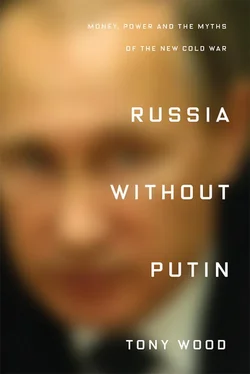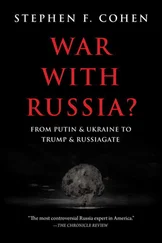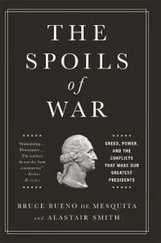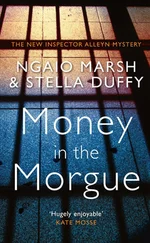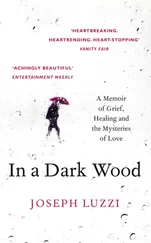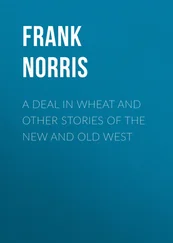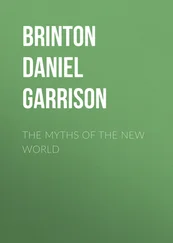The Yukos affair was perhaps the starkest example of how standard business practices of the 1990s seeped into the state sector in the 2000s. The seizure and dismantling of the company was not so much a forcible re-nationalization as a colossal state-directed piece of reiderstvo , the post-Soviet version of corporate raiding. Assets were acquired cheaply by coercive means, with raiders often making physical threats to force the transfer of shares, or else bribing a bureaucrat to issue a court order or start bankruptcy proceedings. They were then resold at a huge profit. The use of state resources was central to these operations. In the 1990s, it was the raiders who bribed the state. Under Putin, state functionaries themselves seized companies, hiring raiders to act on their behalf.
Many explanations for the fate of Yukos have been advanced: Khodorkovsky’s attempts to sell a stake to the US oil major Chevron; his plans to build a private pipeline to China, competing with the state’s line to Japan; his support for opposition parties and apparent desire to run for president in 2008; the personal disrespect he is alleged to have shown to Putin. All of these likely contributed to his downfall. {29} 29 Gustafson’s Wheel of Fortune , ch. 7, offers one of the most judicious accounts of the Yukos affair.
But more than anything, his ruin was intended as a raw demonstration of state power, and to lay out a new elite bargain in which those with links to state power had the upper hand over those who simply had money. Yukos was one of several companies put under pressure by the tax authorities during 2003; others included Norilsk Nickel, Sibneft and Vimpelcom. Within weeks of Khodorkovsky’s arrest, the Federal Assembly’s Accounts Chamber announced it was ‘revisiting’ the outcomes of the 1990s privatizations, while Putin and other officials made statements to the effect that business needed to show ‘social responsibility’, ‘assisting’ the state in its ‘priority tasks’.
This did not mean, however, that those now pressing home their advantage were advancing the interests of the state, let alone those of the public. State companies pursued what were effectively private agendas. During the 2000s, for example, Russia’s state-owned enterprises went on a buying spree, loading themselves with debt in order to acquire more and more assets, not in pursuit of national policy goals but to increase the value of their stocks. {30} 30 Woodruff, ‘Expansion of State Ownership in Russia’.
As OECD economist William Tompson put it, although the state sector did indeed act independently of big business, ‘it did not necessarily act differently’. {31} 31 Tompson, ‘Putin and the “Oligarchs”’, p. 190.
There was, then, an increasing convergence in the logic and practices of the state and private sectors of the economy. This phenomenon was rooted in the close entanglement of business and government over the whole post-Soviet era. While this initially took the form of a parasitic dependency of business on the state, by the mid-1990s the business elite had begun to penetrate the state and indeed aspire to control it. The reassertion of state authority after 2000, and increased hydrocarbon revenues, changed the terms of the equation. But what took place under Putin was not simply a push in the opposite direction from the 1990s. Rather, there was a synthesis of the realms of government and business – the features of one merging with those of the other. This melding of state and business spheres accounts for many of the most damaging aspects of the way Russia is ruled today; it also means that we need to think differently about who is doing the ruling.
Over the course of the 2000s, a widespread consensus developed that Putin had set in place a ‘neo-KGB state’, a ‘praetorian regime run by people from the secret services’ whose authoritarian instincts explained the darkening prospects for democracy and free speech in Russia. {32} 32 See for instance ‘The Making of a Neo-KGB State’, Economist , 25 August 2007, and Lilia Shevtsova, ‘The Next Russian Revolution’, Current History , October 2012; both cited in David Rivera and Sharon Werning Rivera, ‘Is Russia a Militocracy?’, Post-Soviet Affairs , vol. 30, no. 1, 2014, p. 28.
After all, Putin himself had come from the ranks of the KGB, and he steadily recruited more men from the security services into his government. The siloviki , as they were known – after the ‘power structures’, silovye struktury , from which they originated – included some of Putin’s closest allies: Igor Sechin, chairman of Rosneft; Sergei Ivanov, defence minister from 2001 to 2007 and later Putin’s chief of staff; and Viktor Ivanov, who from 2008 to 2016 was head of the FSKN, the federal anti-drug agency. But there were many more, all the way down the chain of command.
The empirical basis for the idea of a creeping silovik takeover came from Olga Kryshtanovskaia and Stephen White, who in a series of influential articles characterized Putin’s rule as a ‘militocracy’. In 2003, they calculated that across several key sectors of government, the proportion of current and former security service personnel had risen sharply from the Yeltsin era, accounting for a quarter of the political elite; in 2009, they argued that the proportion had increased to almost one-third. {33} 33 Olga Kryshtanovskaya and Stephen White, ‘Putin’s Militocracy’, Post-Soviet Affairs , vol. 19, no. 4, 2003, p. 293, Table 1; Kryshtanovskaya and White, ‘The Sovietisation of Russian Politics’, Post-Soviet Affairs , vol. 25, no. 4, 2009, p. 295, Table 2.
The idea seemed plausible, especially given Putin’s own background and the macho security-service language that set the tone for much of his time in office. It certainly resonated strongly far beyond academic and policymaking circles, both in Russia and in the West. For two Russian journalists, Andrei Soldatov and Irina Borogan, this cluster of uniforms constituted a ‘new nobility’. In a grim satire set in 2028, Vladimir Sorokin, enfant terrible of Russian literature, reimagined them as a deeper throwback, to the oprichnina , Ivan the Terrible’s private army, which terrorized Muscovy in the late sixteenth century. {34} 34 Andrei Soldatov and Irina Borogan, The New Nobility: The Restoration of Russia’s Security State and the Enduring Legacy of the KGB , New York 2011; Vladimir Sorokin, Day of the Oprichnik [2006], New York 2010.
In another phantasmagorical satire on post-Soviet reality, novelist Viktor Pelevin took a trope in wide circulation at the time, the ‘werewolf in epaulets’, and made it literal, depicting Russia’s current rulers as petroleum-worshipping beasts in KGB attire, howling at the earth to deliver the bounty on which their power depended. {35} 35 Viktor Pelevin, The Sacred Book of the Werewolf [2004], London 2008, pp. 218–20.
But the term ‘militocracy’ is misleading for several reasons. One is that the apparent rise of the siloviki predates Putin. To take only the obvious examples, among the Yeltsin-era appointees with a KGB background were Aleksandr Korzhakov, the president’s bodyguard, as well as three successive prime ministers – Evgeny Primakov, Sergei Stepashin and, of course, Putin himself. Second, the category of silovik itself is too broad. As used by Kryshtanovskaia and White, it tends to conflate actual military personnel with, say, clerical staff working at a ‘power ministry’. It also makes no allowance for the nature or duration of service: statistically, an employee of six months’ standing in the PR department of the Emergencies Ministry is as much a silovik as a KGB general with several decades of experience. {36} 36 These objections are laid out meticulously by Rivera and Rivera, ‘Is Russia a Militocracy?’, to which I am indebted.
Читать дальше
